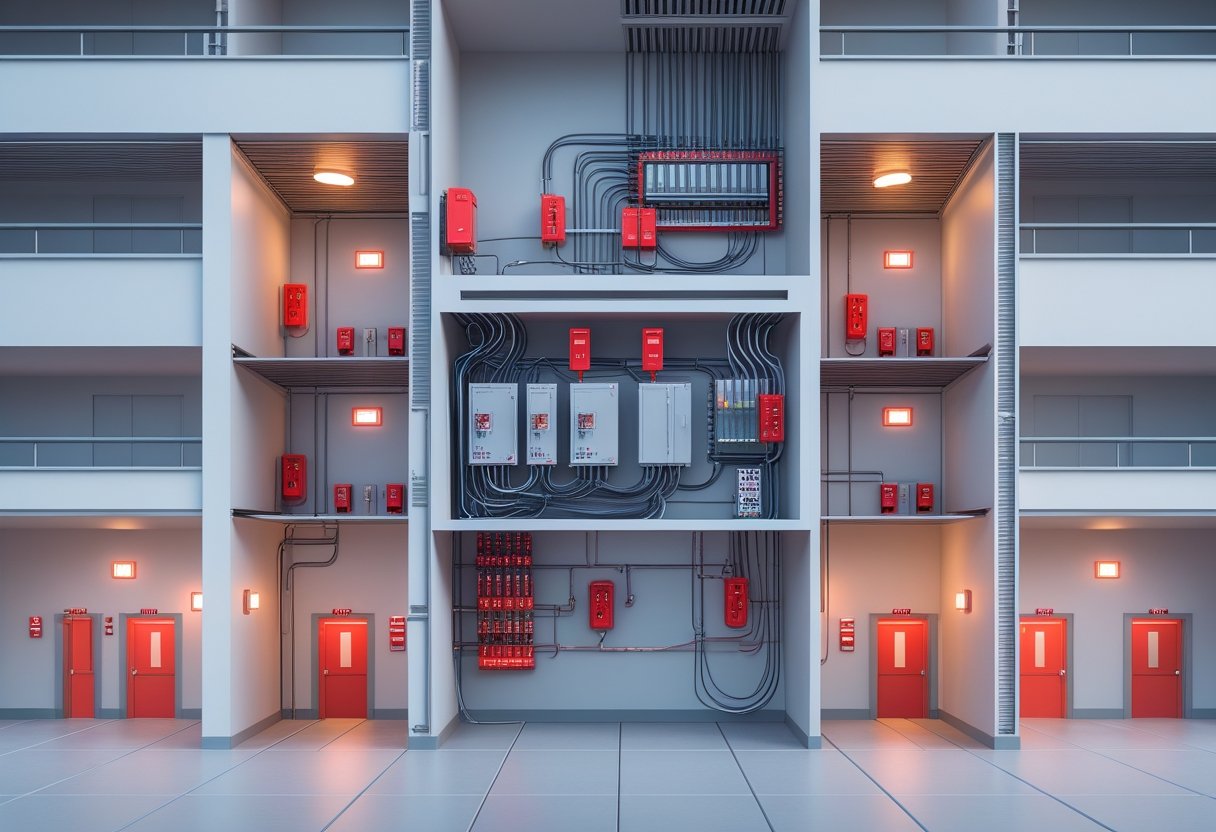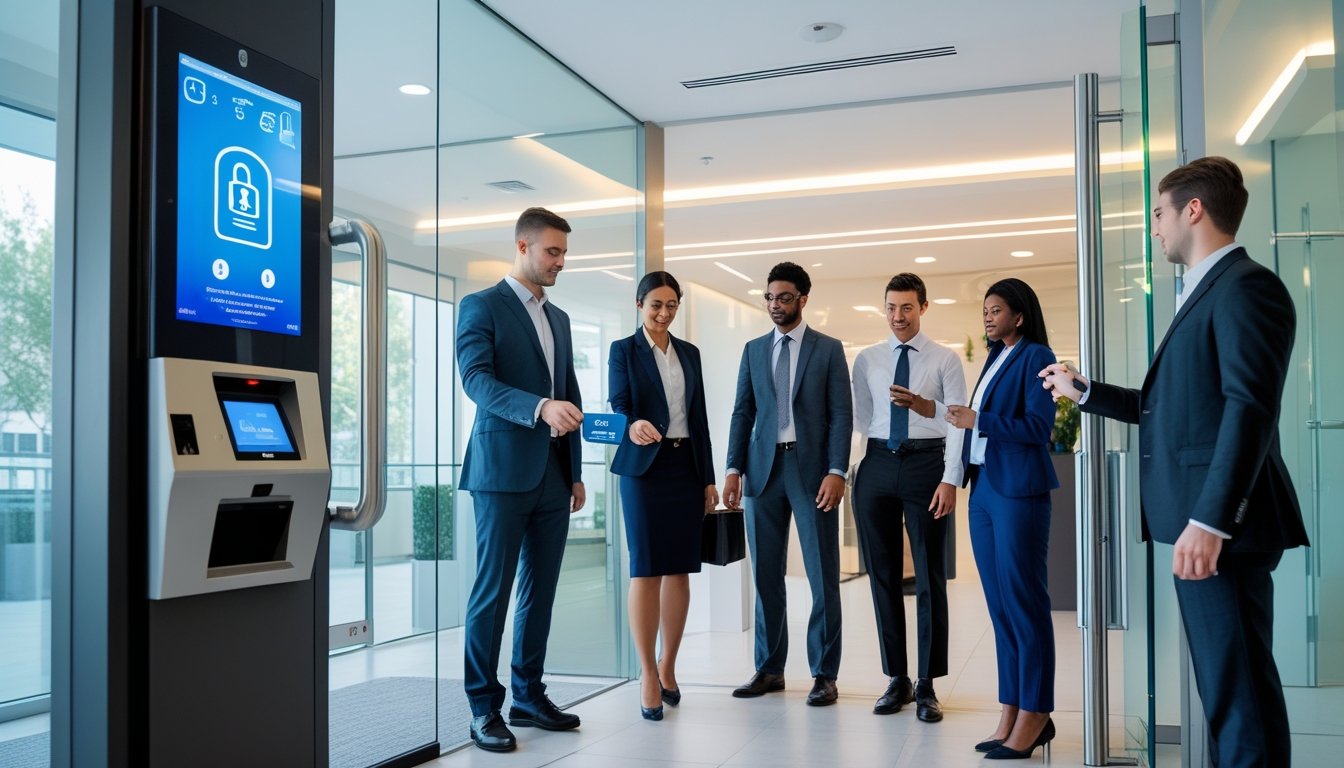In multi-tenant buildings, ensuring the safety of all residents hinges on a reliable fire alarm system tailored to the unique challenges of shared spaces. A properly designed fire alarm system provides essential alerts that can save lives, protect property, and comply with local safety regulations. Understanding the specific requirements for these systems can help you make informed decisions about the installation and maintenance of fire safety measures.
Navigating the standards set by organizations like the NFPA is crucial for multi-family dwellings. These regulations outline the placement, sound levels, and features of fire alarm systems to optimize safety in shared living environments. As you explore your options, consider how these systems can integrate effectively within your building's architecture while addressing the needs of diverse tenants.
With a thorough grasp of the requirements and best practices, you can ensure your multi-tenant building remains a safe haven. Proper planning and execution will not only enhance safety but also foster peace of mind for all residents, knowing they are well-protected in case of emergencies.
Key Components of Fire Alarm Systems for Multi-Tenant Buildings
In multi-tenant buildings, fire alarm systems play a crucial role in ensuring safety and effective emergency response. Understanding the specific components and their functions is vital for effective fire protection.
Fire Alarm Control Panel Functions
The fire alarm control panel (FACP) serves as the central hub for your fire alarm system. It monitors inputs from various detectors and devices, processing information to identify alarms and faults. This control panel displays the system's status through visual indicators, allowing you to quickly assess the situation.
Key functions include initiating alarm signals and managing the communication with other systems, such as sprinklers and emergency voice evacuation systems. Training personnel to operate the FACP ensures quick responses during emergencies, which is critical in a multi-tenant environment.
Emergency Voice Evacuation System Integration
An emergency voice evacuation system enhances safety measures by providing clear, direct instructions during an alarm. This integrated system delivers pre-recorded or live announcements to guide occupants to safety.
In multi-tenant buildings, it's crucial to tailor messages for different areas and populations. For example, high-occupancy areas may require different instructions than residential units. The effectiveness of these systems helps minimize confusion and ensures a coordinated evacuation process.
Types of Detectors and Pull Stations
Fire detection is achieved through various types of detectors and pull stations, each designed to respond to specific fire scenarios. Common types include:
- Heat Detectors: Activate when a certain temperature threshold is reached, ideal for kitchens or storage areas.
- Smoke Detectors: More sensitive to smoke particles and suitable for general living and office spaces.
- Manual Pull Stations: Allow occupants to trigger alarms manually, increasing your control over the situation.
These components must be strategically placed throughout the building to guarantee comprehensive coverage and quick response during emergencies.
Sprinkler Systems and Fire Protection Devices
In conjunction with alarm systems, sprinkler systems act as a primary defense against fires. They can automatically douse flames, significantly reducing fire damage and enhancing safety.
Fire protection devices, such as fire extinguishers and fire hoses, should also be strategically located throughout multi-tenant buildings. Ensure that all devices are regularly inspected and maintained to keep them in working order. Proper training for tenants and staff on the use of these devices further enhances overall safety measures.
Design and Planning Considerations
In multi-tenant buildings, effectively designing and planning a fire alarm system involves understanding the unique needs of each tenant and ensuring seamless integration with existing infrastructure. Key considerations include coordination between developers and tenants, scalability for future growth, and integration with building automation systems.
Coordination Between Developer and Tenant Systems
Establishing clear communication between developers and tenants is crucial for a functional fire alarm system. You should outline specifications including the type and location of the fire alarm control panel. This collaboration ensures that each unit's system meets safety standards while aligning with the building's overall design.
Consider creating a checklist that includes:
- Fire alarm type
- Required features
- Installation timelines
This thorough approach helps prevent conflicts during the installation process and guarantees that both parties have a clear understanding of responsibilities.
Scalability and Expansion Requirements
Designing a scalable fire alarm system is essential for accommodating future expansions or changes. You need to assess how additional units or modifications might impact the existing system. A flexible fire alarm control panel supports integration with new sensors or alarms without significant rework.
Key factors to focus on include:
- Modular components
- Compatibility with current systems
- Future regulatory compliance
By planning for scalability, you ensure that the fire alarm system can adapt as your building evolves, providing consistent safety for all tenants.
Integration with Building Automation
Fire alarm systems must seamlessly integrate with building automation systems to enhance safety and efficiency. You want to ensure that your fire alarm control panel can communicate effectively with other systems such as lighting and HVAC.
Consider these integration points:
- Notification systems
- Emergency lighting activation
- Automated evacuation protocols
This integration allows for quicker responses during emergencies and improves the overall safety infrastructure of your building. By aligning these systems, you enhance tenant safety and streamline emergency responses in multi-tenant structures.
Installation and Commissioning Best Practices
Proper installation and commissioning of fire alarm systems are crucial for ensuring safety in multi-tenant buildings. You need to navigate various responsibilities, meet tenant requirements, and maintain comprehensive documentation to achieve seamless operations.
Developer Responsibilities and Standards
As a developer, your primary responsibility is to ensure that the fire alarm system complies with local codes and standards, such as NFPA 72. Collaborate closely with fire protection engineers and adhere to industry best practices.
Key responsibilities include:
- Selecting a suitable fire alarm control panel that meets the building's requirements.
- Ensuring proper placement of alarms and detectors in accordance with design plans.
- Conducting thorough inspections before commissioning.
Always prioritize coordination with local fire marshals to avoid non-compliance issues. Depending on the complexity of the system, conducting integrated testing may be beneficial to validate that all components function correctly together.
Tenant Fit-Out Requirements
For tenant fit-outs, it’s essential to establish specific requirements for the fire alarm system that align with each tenant's unique needs. Coordinate with tenants early in the design phase to outline expectations.
Consider the following:
- Ensure that the fire alarm components, such as sound levels and alarm notification devices, comply with tenant needs.
- Specify installation guidelines to minimize the risk of false alarms during normal tenant activities.
- Provide training on the system's operation and emergency procedures for tenant staff.
This proactive approach helps integrate the fire alarm systems smoothly into the tenant spaces while maintaining compliance with applicable regulations.
Testing and Commissioning Documentation
Testing and commissioning documentation is vital for validating the performance of your fire alarm system. Maintain a detailed record of all tests conducted on the system components to ensure compliance and proper functionality.
Documentation should include:
- Test results for all installed devices, including sensors and alarms.
- A certificate of compliance that demonstrates adherence to standards and regulations.
- A maintenance checklist to guide ongoing inspections and adjustments.
This thorough documentation serves as a reference for future maintenance and any potential inspections by local authorities. It reinforces your commitment to safety within multi-tenant buildings in the greater Houston area.
System Operation and Ongoing Maintenance
Effective operation and maintenance of fire alarm systems in multi-tenant buildings are essential for ensuring safety and compliance. Regular inspections, clear procedures, and the upkeep of emergency notification devices form the backbone of a reliable fire safety strategy.
Regular Inspections and Monitoring
Regular inspections of your fire alarm system are crucial. Schedule monthly checks to ensure all devices, including smoke detectors and alarms, are functioning properly.
Consider implementing a monitoring system that connects to a central station. This allows for immediate alerting of the fire alarm control panel in case of an emergency.
Documentation of each inspection should be maintained. Create a checklist to verify:
- Functionality of every alarm and control panel.
- Sensitivity testing for smoke detectors.
- Battery checks for backup systems.
Keep logs accessible for inspections to ensure compliance with local regulations in Houston.
Standard Operating Procedures for Alarms
Establish standard operating procedures (SOPs) for your fire alarm system. Clear guidelines help tenants understand their responsibilities during an alarm event.
Your SOP should include:
- Immediate actions to be taken upon alarm activation, such as notifying emergency personnel.
- Evacuation routes clearly posted within common areas.
- Training sessions for all tenants, including how to use emergency voice evacuation systems.
Regular drills will familiarize occupants with evacuation procedures, minimizing confusion during an actual incident.
Maintenance of Emergency Notification Devices
The maintenance of emergency notification devices, such as your emergency voice evacuation system, is equally important. Ensure bi-annual tests of these systems to verify alert audibility across all areas.
Perform the following tasks:
- Inspect speaker functionality to guarantee clear messaging.
- Check wiring connections for any signs of wear or damage.
Schedule these tests to coincide with your regular fire alarm inspections. Prompt maintenance will reduce the risk of system failure during emergencies, providing peace of mind for you and your tenants.
Regulatory Compliance and Local Code Requirements
Ensuring regulatory compliance for your fire alarm system in a multi-tenant building is critical. Local codes and national standards dictate system installation, maintenance, and operational protocols that promote safety. Key areas of focus include NFPA 72 and accessibility provisions.
NFPA 72 and Other Relevant Standards
NFPA 72 lays out the national standards for fire alarm systems. Key requirements include the placement and operation of the fire alarm control panel and notification appliances.
Key Considerations:
- Installation: Fire alarm systems must be installed in accessible areas and according to plans approved by local authorities.
- Inspection: Regular inspections are mandated to ensure the system operates effectively. This includes testing all initiating devices, notification appliances, and the control panel.
- Maintenance: Ongoing maintenance must comply with NFPA 72 guidelines, ensuring that batteries and other components are functioning optimally.
Understanding these requirements helps you manage liability and enhance tenant safety.
ADA and Accessibility Provisions
The Americans with Disabilities Act (ADA) mandates that fire alarm systems cater to individuals with disabilities. This includes specific provisions for visual and audible alarms.
Accessibility Guidelines:
- Alarms: Install both visual strobe lights and audible alarms to ensure that all tenants are notified in case of fire.
- Control Panel Access: The fire alarm control panel should be located in an easily accessible area for individuals with mobility impairments.
- Evacuation Plans: Clear and accessible signage should indicate evacuation routes and include visual representations for better comprehension.
Adhering to these accessibility provisions not only aligns with regulatory requirements but also ensures that all residents can respond effectively in emergencies.
Frequently Asked Questions
When considering a fire alarm system for your multi-tenant building, there are several key aspects to address. These include essential components of the system, relevant regulations, cost influences, and differences between commercial and residential requirements, among other important factors.
What are the essential components of a fire alarm system for multi-tenant residential buildings?
A reliable fire alarm system for multi-tenant residential buildings typically includes smoke detectors, heat detectors, manual pull stations, and notification appliances like alarms and strobe lights. These components work together to ensure that occupants are alerted quickly in case of a fire. Additionally, a central control panel integrates all devices and allows for monitoring and management of the entire system.
How does NFPA 72 regulations affect fire alarm system requirements in mixed-use or multi-tenant structures?
NFPA 72 outlines specific guidelines for fire alarm systems, including installation, maintenance, and testing standards. These regulations ensure that systems meet safety requirements in multi-tenant and mixed-use buildings. Adhering to NFPA 72 can influence design choices and the type of equipment required, ensuring compliance and enhancing safety for all occupants.
What factors influence the cost of installing a fire alarm system in a multi-tenant building?
Several factors can affect installation costs, including the building’s size, layout, and the number of floors. The selection of equipment also plays a critical role, as advanced systems may require higher investment. Additionally, local labor costs and the complexity of the installation process can further influence the overall expenditure.
Are there different requirements for fire alarm systems in commercial vs. residential sections of a multi-tenant building?
Yes, the requirements can differ significantly. Commercial areas may require more sophisticated fire alarm systems with additional features, such as advanced smoke detection technology or integration with other safety systems. Residential sections typically adhere to simpler standards focusing on basic detection and notification capabilities.
What are the most effective initiating devices for fire alarm systems in multi-tenant residential buildings?
In multi-tenant residential buildings, effective initiating devices include photoelectric and ionization smoke detectors, as well as heat detectors. Photoelectric detectors are particularly good at detecting smoldering fires, while ionization detectors respond quickly to fast-flaming fires. Combining these devices can enhance overall safety by addressing different fire types effectively.
How do local building codes determine the necessity of fire alarm systems in multi-tenant buildings?
Local building codes establish specific requirements based on occupancy type, building size, and usage. These codes may dictate when fire alarm systems are necessary and what features must be included. It's critical to consult with local authorities to ensure compliance and appropriate installation tailored to your building's unique characteristics.
.svg)



.svg)


.svg)



